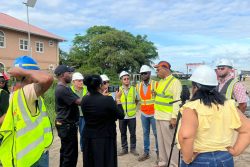Towards the end of last year, and having collaborated with colleagues in the authorship of a report on agri-food systems in Latin America and the Caribbean, Michael Morris, an expert on agriculture at the World Bank, gave an incisive interview on agricultural systems in the region, examining their strengths and weaknesses and providing a perspective on how those systems can be refined and improved to take account of better fulfilling its obligation to realising food security in the region and secondly, adopting systems that seek to mitigate the effects of climate change.
In the context of the current challenges confronting agriculture in the Caribbean, not just those that have to do with how it can solve the regional food security challenge, maximise export earnings, and help to push back the climate change challenge, the Stabroek Business publishes a summary of Mr. Morris’ responses to questions put to him on agriculture in LAC countries. His responses have been edited for length, and to allow for the smooth flow of what he says.
Agriculture and food systems in the Latin America and the Caribbean Region (LAC) are rightfully recognised as among the most successful on the planet. They have fed a fast-growing population, facilitated economic development, enabled urbanisation, generated significant export revenues, and contributed to reducing hunger and poverty, including for the estimated 20 million households classified as small-scale producers or family farmers. Moreover, they have proved remarkably resilient in the face of the COVID-19 pandemic, and played a beneficial countercyclical role by ensuring largely adequate food supplies and stable food prices in global markets.
Latin America and the Caribbean is the world’s largest net food exporting region, and food exports from the region help to lower and stabilize international food prices, bringing benefits to consumers everywhere. In addition, LAC is the world’s largest producer of ecosystem services, and its vast forests and extensive savannahs play a critical role in shaping global weather patterns and mitigating climate change.
Despite these contributions, however, the public image of LAC agriculture and food systems as dynamic, productive, and efficient reflects only part of a more complicated reality. In many ways, Latin America and Caribbean agriculture and food systems are underperforming. They have been slow to respond to changes in the global environment, and many continue to rely on centuries-old production methods that are outdated, inefficient, and harmful to people and to the environment.
Fortunately, the outlook is not all negative. Against the current backdrop of underperformance, enormous opportunities are waiting to be seized. Technological advances are ushering in new, more efficient, and more environmentally friendly ways to produce, process, distribute, consume, and recycle food, magnifying the potential payoffs to the adoption of improved technologies and practices.
Even though some farmers and ranchers have been at the forefront of adopting green technology, agriculture and food systems in many LAC countries are dominated by production models based on unsustainable practices that undermine ecosystem services critical for human well-being, while also generating significant greenhouse gas emissions that are an important contributor to climate change. LAC agricultural emissions make up almost one-half of the region’s emissions, and agriculture and ranching are responsible for 70% of regional habitat conversion, while the deforestation rate in LAC is three times the global average. The current production models threaten the viability of LAC food production capacity and will need to be replaced with better models that enhance productivity, reduce food loss and waste, and ensure the sustainability of the natural resource base on which agriculture depends, increasing the provision of ecosystem services and enhancing climate resilience.
One approach (to addressing these issues) is the circular economy, to take advantage of better land management, energy and water consumption, waste management and pollution prevention. Technological innovations such as precision agriculture, water reuse, bioenergy and bio-fertilizer or smart agriculture offer numerous opportunities to complement this approach. This enables intensive and efficient use of resources, high productivity with a low environmental footprint and increased climate resilience.
While the full scale of the pandemic’s effects is still unfolding, the impacts on LAC agriculture and food systems are being felt in multiple dimensions. Fortunately, primary production has proved remarkably resilient, in the sense that most farmers and livestock keepers have been able to continue producing. In contrast, challenges have often appeared downstream in the supply chain, as the flow of many food products has been disrupted by mobility restrictions that have caused bottlenecks in distribution or impeded redirecting flows of food.
But there´s no doubt that the agriculture and food sector can play a vital role in supporting a sustainable economic recovery in LAC by safeguarding the region’s food supply, providing employment for millions, generating foreign exchange earnings in net food exporting countries, improving the balance-of-trade in net food importing countries, and restoring the ecosystem services on which the long-term welfare of the planet depends.
The recovery provides an opportunity to build back better. Systems, policies, institutions in the post-COVID-19 transition will need to be reframed to ensure cleaner, greener, and more inclusive foodscapes and quality, safe and more nutritious food. Jobs and economic transformation should be at the centre of this forward-looking strategy.
Several drivers could affect future LAC agriculture and food systems. These drivers fall into two categories – trends and disruptors. Trends are long-term forces like population growth, income growth, and urbanisation, which will have a powerful effect on agriculture and food systems. These are, however, slow-moving and to a large extent predictable, so governments should be better equipped to address them.
In contrast, disruptors are sudden forces like technological breakthroughs, catastrophic weather events, global disease pandemics, or radical shifts in governments’ policies. Disruptors also can have large impacts on food systems, but because they can occur rapidly and without warning, it is more difficult to prepare for them.







